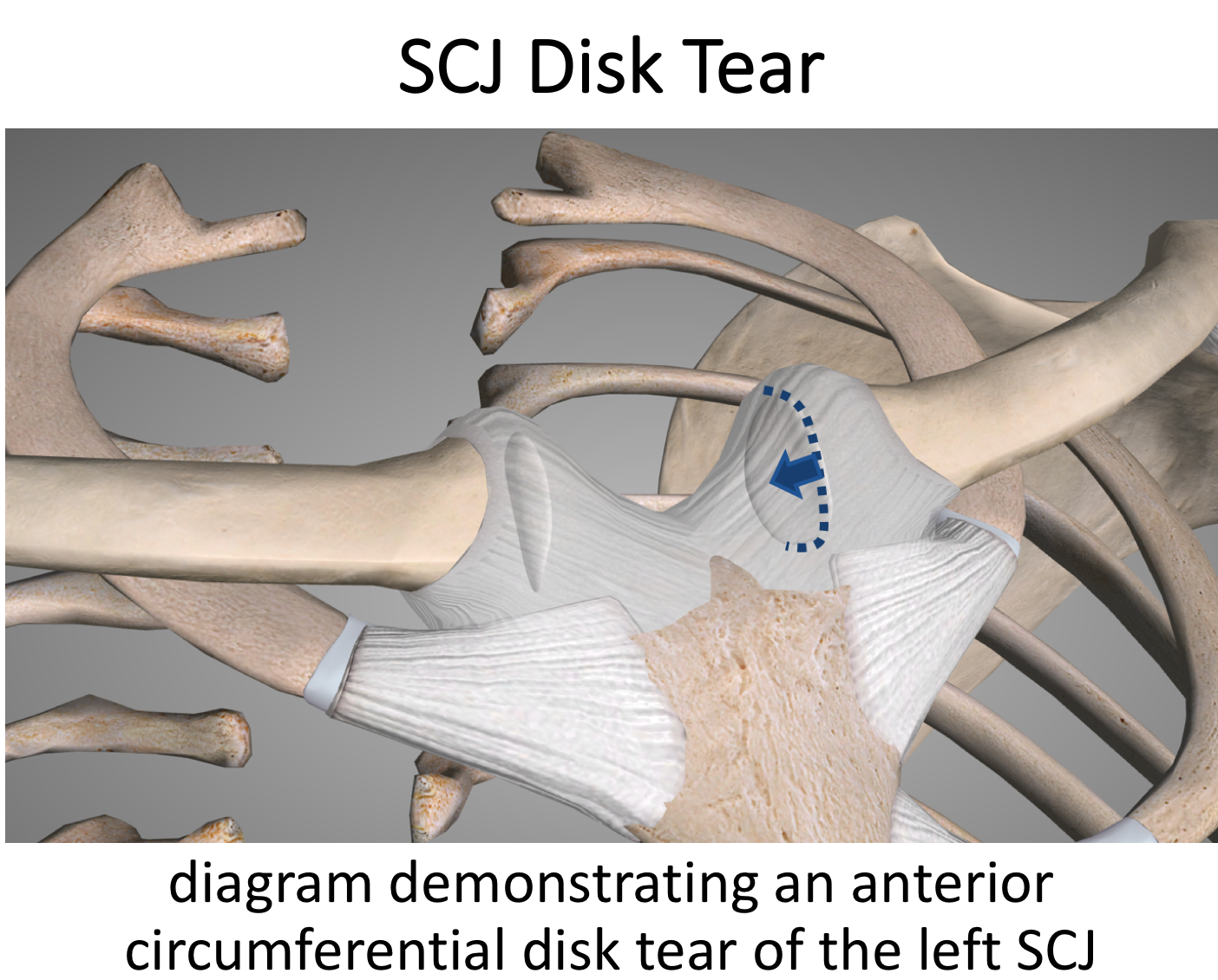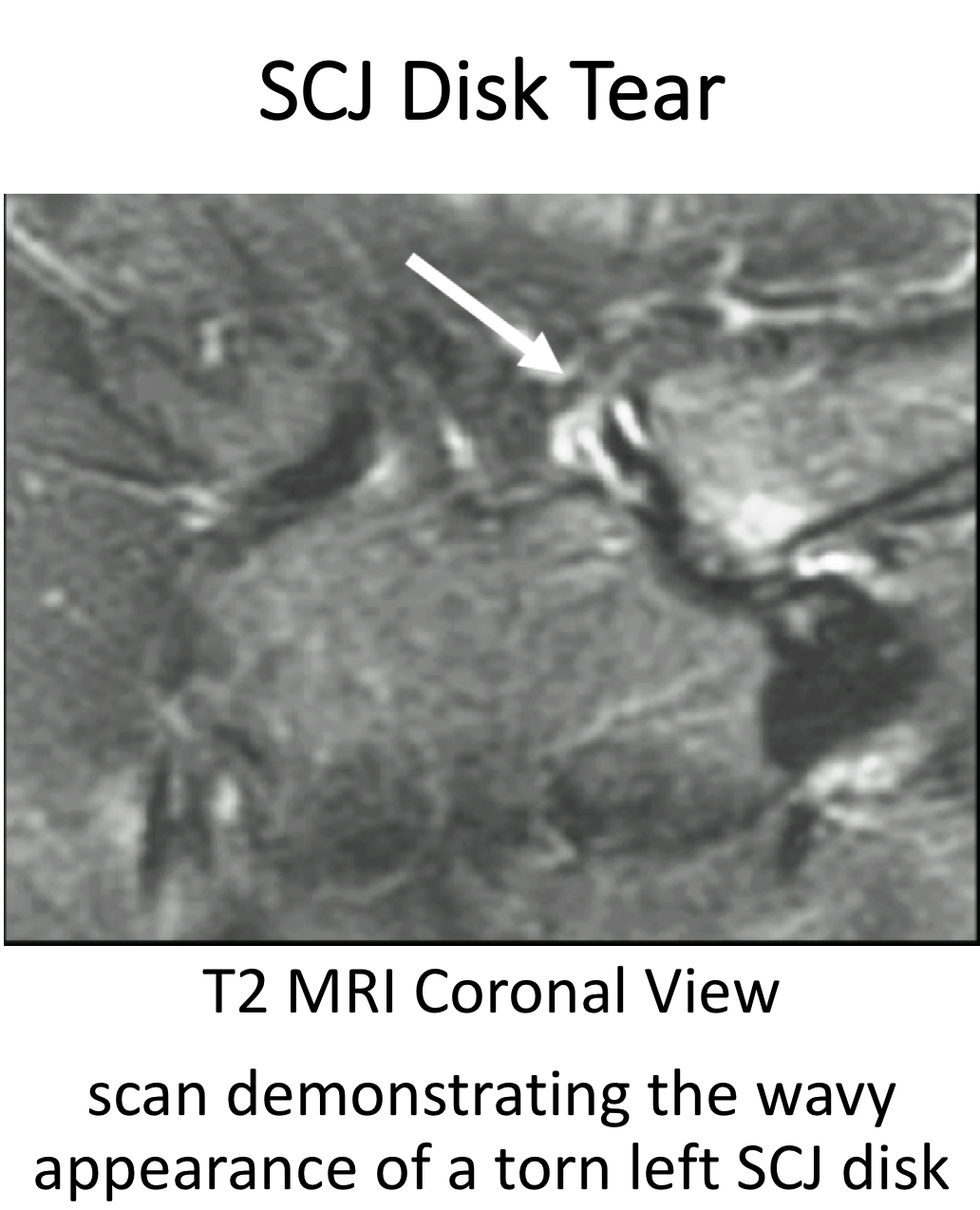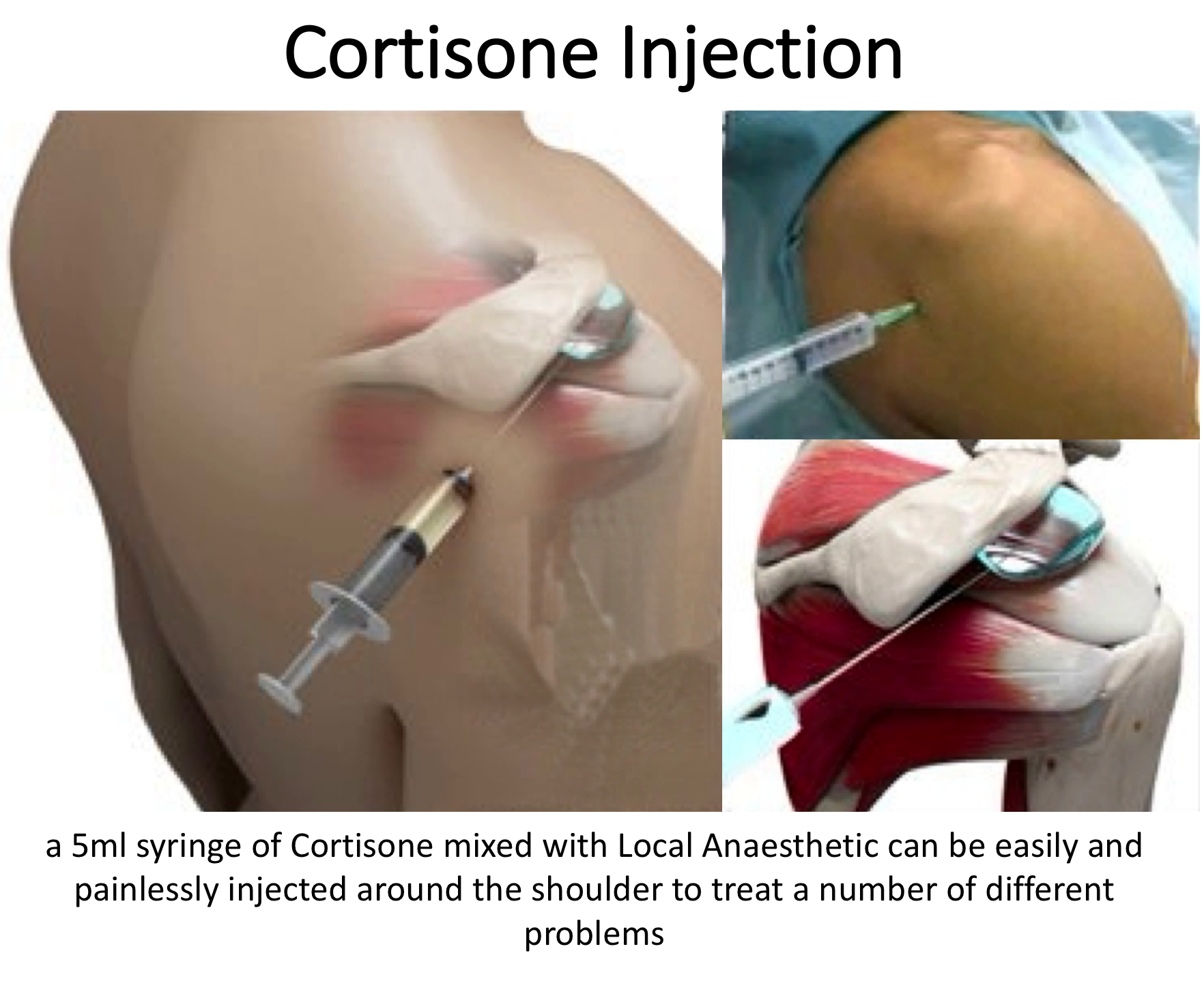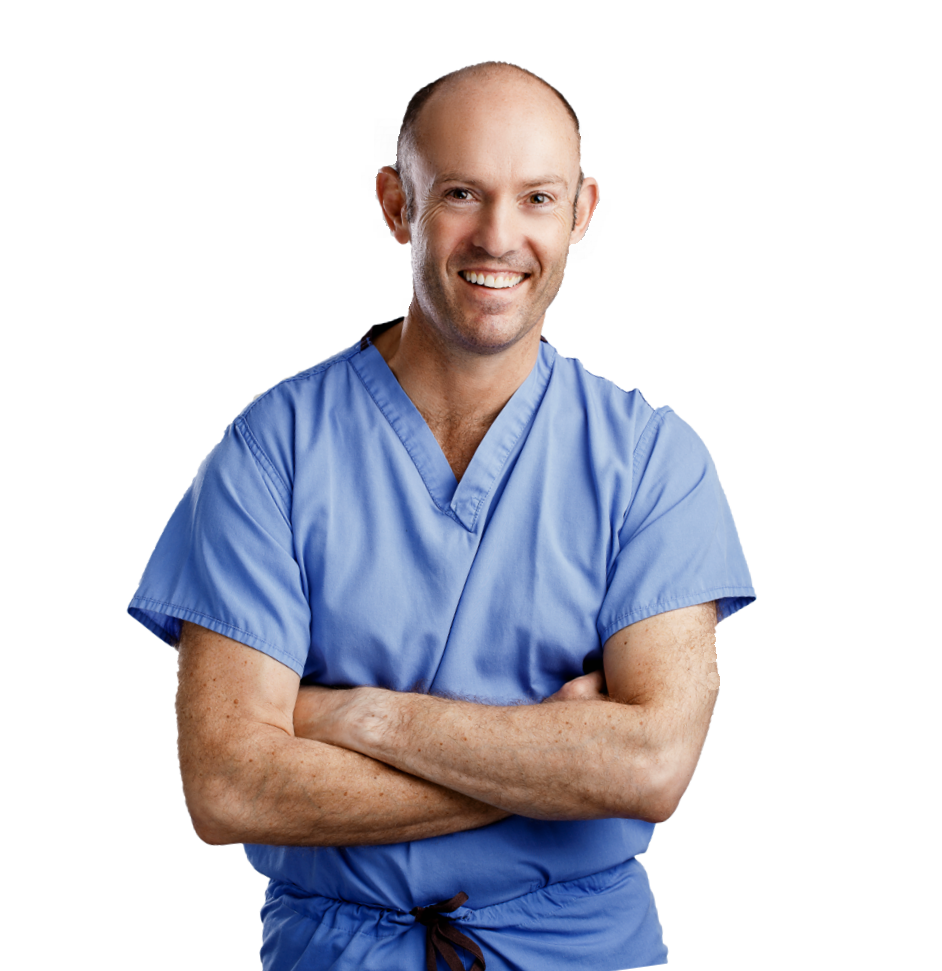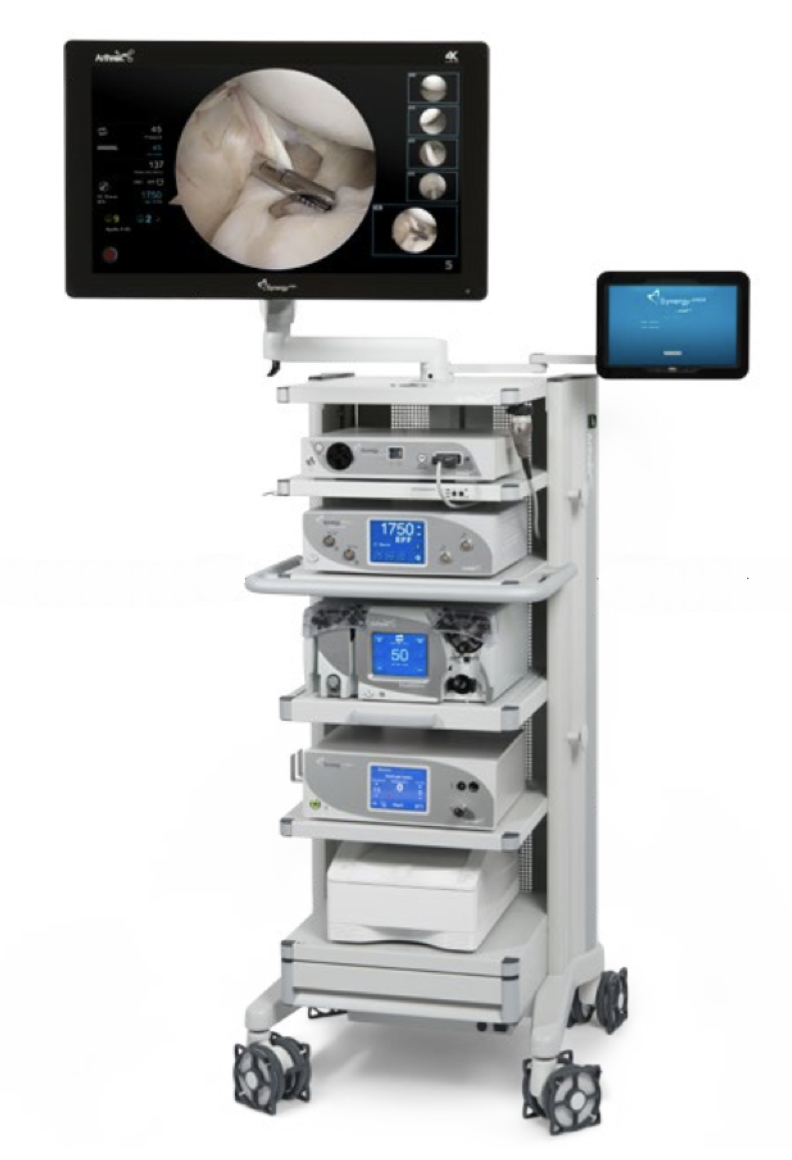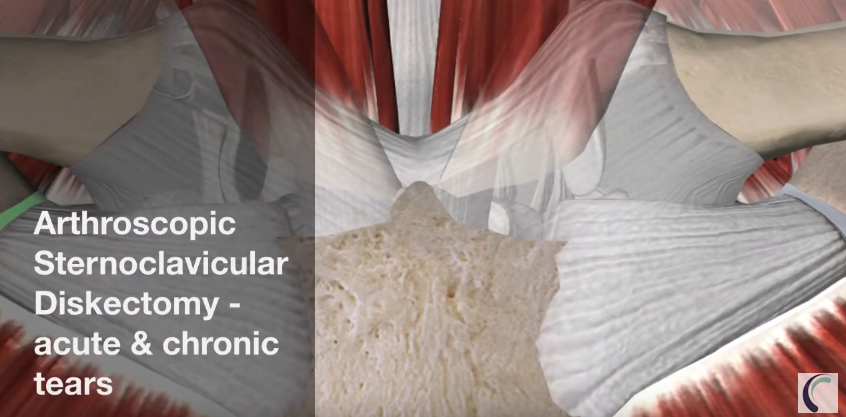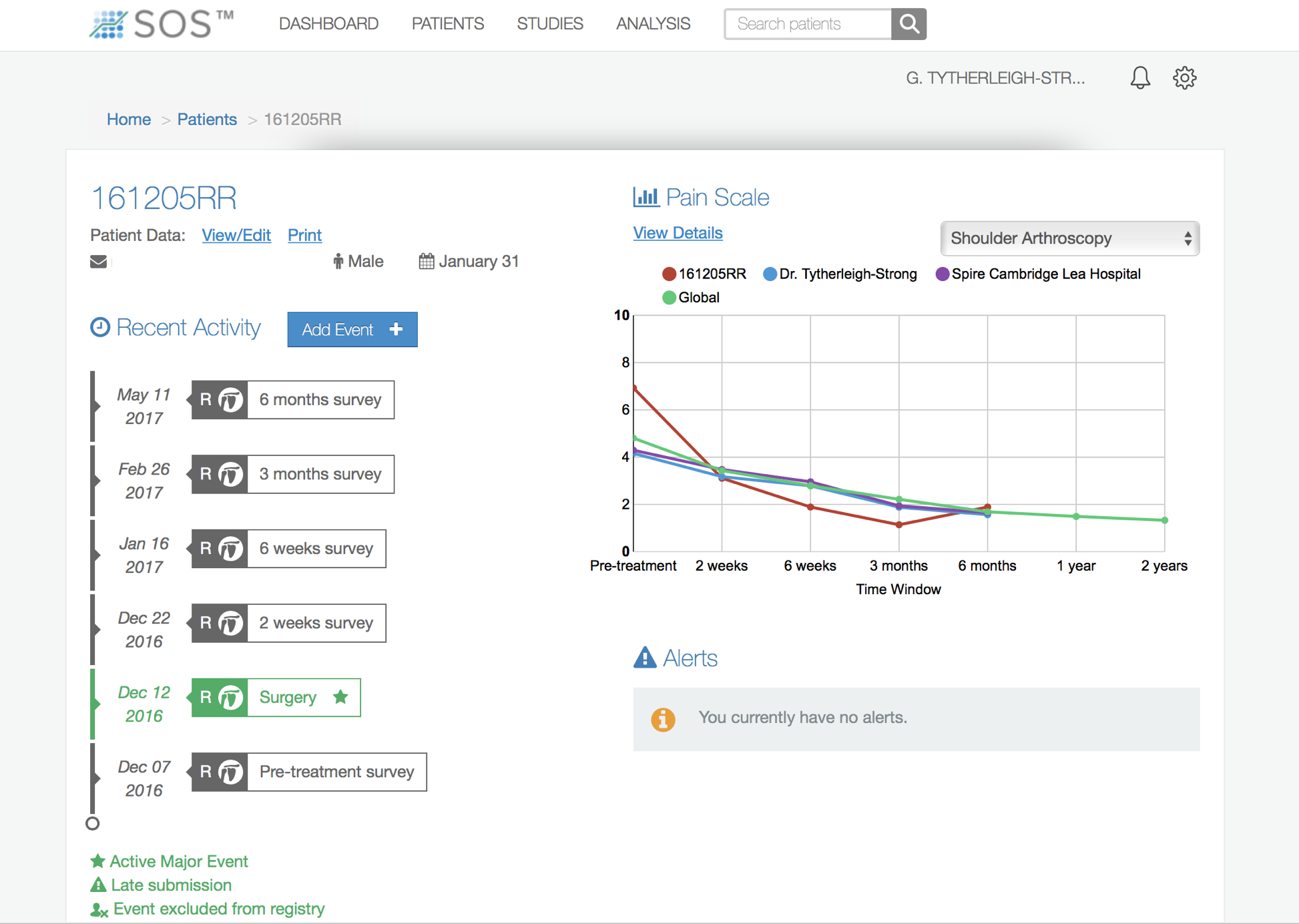Disk Tears
SCJ Intra-Articular Disk Tears
- like the menisci (cartilages) in the knee the intra-articular disk in the SCJ is vulnerable to tearing when the joint is injured (Acute Tear) and as osteoarthritis develops (Chronic Tear)
- whilst this has been known for a long time it is only relatively recently that we have appreciated that a torn disk, on its own, maybe responsible for the SCJ symptoms that some people are experiencing
- Acute Disk Tears are very rare and occur in younger patients as the result of a specific injury or a repetitive action.
Chronic Disk Tears develop in most people with SCJ osteoarthritis but, like SCJ OA, are usually asymptomatic
Who gets SCJ Intra-Articular Disk Tears?
- Acute Tears –
- Acute Tears are rare and occur following an SCJ injury in younger people
- the mechanism and extent of the injury can range from a complete dislocation or subluxation of the SCJ, to a shearing or loading injury when someone falls awkwardly or wrenches their shoulder playing sport
- most injuries occur playing sport – combat (rugby or martial arts) – falling (skiing or gymnastics) – playing an awkward shot (tennis or hockey)
- Chronic Tears –
- Chronic Tears are very common and occur in most patients with SCJ OA, but are usually asymptomatic
- very occasionally, when someone with SCJ OA is symptomatic, the symptoms are entirely due to the mechanical problem created by the torn disk rather than from the OA
What are the symptoms of an SCJ Intra-Articular Disk Tear?
- the main symptoms of a SCJ disk tear are mechanical
- patients often feel a clicking, popping or grinding sensation in the joint as they move it into certain positions
- this may or may not be painful
- sometimes it can feel as if the joint is slightly ‘jumping’ forward
- the SCJ may be swollen and painful
- sometimes the joint may appear swollen and painful to touch
- this may only occur after activity
How do you diagnose an SCJ Intra-Articular Disk Tear?
- History
- Acute Tear
- most people who sustain an acute SCJ disk tear do so as the result of a specific injury. Sometimes they may have sustained other, more significant, injuries at the time and only notice their SCJ symptoms afterwards
- occasionally an acute tear may be the result of a repetitive action or injury to the SCJ playing a particular sport. The symptoms may then develop gradually
- Chronic Tear
- Acute Tear
most chronic tears occur on a background of SCJ OA
- the symptoms often begin gradually although can occur after a specific injury creating an acute on chronic tear
- patients with SCJ OA and a symptomatic disk tear tend to mainly have mechanical symptoms with far less pain than usual
- Examination –
- following an acute injury, the joint is maybe and swollen but often it is normal and even may be reddened due to inflammation
- ‘clicking’, ‘grinding’ and ‘jumping’ can be felt over the joint on protraction and retraction of the shoulders, on internal and external rotation and on elevation of the arm
- Investigations –
- X-Ray – a standard x-ray of the SCJ is often difficult to interpret due to the presence of the vertebral column and ribs superimposed behind it
- Plain Tomogram – this is often used to rule out another cause of symptoms, particularly in chronic tears.find out more about SCJ tomograms …
- MRI Scan – an MRI scan gives is the best investigation to diagnose an SCJ disk tear. It can give an idea of the size and extent of the tear, whether it is acute or chronic and if there are any other associated problems
Find out more about imaging around the shoulder….
Management of an SCJ Intra-Articular Disk Tears
The majority of patients with a symptomatic SCJ Disk Tear have had their problems for a long time before they reach an appropriate Orthopaedic Surgeon. The majority of their symptoms are mechanical and due to the damaged intra-articular disk. If this is the case, then it is likely that only surgery will be able to improve these. However, if pain has become a significant feature it may initially be worth treating this first, particularly in the case of a chronic tear with associated SCJ OA.
Analgesia/Pain Relief & Anti-Inflammatories
- NSAID (Non-Steroidal Anti-Inflammatories) –
- NSAIDs work be reducing the painful inflammatory response, they can be taken regularly as a prescribed course or as symptoms require
- NSAIDs can damage the stomach lining and affect the kidneys. It is important that a patient’s Family Doctor prescribes this medication if it is going to be used for a longer term
- Codeine based Analgesics –
- Codeine based analgesics are pain killers and affect a patient’s perception of pain. As a result, they can have some effect on consciousness depending on their strength
- Codeine based analgesics can lead to constipation if taken for a longer time. Having a high-fibre diet or even taking laxatives might need to be considered
Cortisone Injection
- Cortisone is a corticosteroid that is naturally produced by the body’s Adrenal Gland. Injectable Cortisone is synthetically produced and has a very powerful ant-inflammatory action. When injected into the SCJ it has the potential of settling severe inflammation, allowing the patient to undertake their rehabilitation exercises.
- a Cortisone injection can be very helpful for resistant painful SCJ
- due to the small size of the SCJ and the important other structures around it a Cortisone injection needs to be administered under Ultrasound guidance
- it can often take several days to have an effect
- the risks of a single Cortisone injection are very small, however multiple injections are not advised
Physiotherapy
- is someone has had longstanding problems with their SCJ the often subconsciously develop compensatory movements and mechanisms to maintain function whilst working around the pain. This can sometimes lead to other problems elsewhere around the shoulder girdle
- physiotherapy can be very useful in regaining normal SCJ and shoulder function once the pain and discomfort has settled and to ‘un-learn’ the compensatory ‘bad-habits’
Surgery for SCJ Intra-Articular Disk Tears
- Until recently it was not really appreciated that a torn SCJ intra-articular disk might be the cause of some peoples’ SCJ problems. This may partly be due to the fact that an MRI scan is usually required to make the diagnosis.
- There have been a few historical case reports of patients with a torn SCJ, diagnosed mainly on clinical grounds, who underwent a successful open excision of the torn disk and eventually made a good recovery.
- However, it has generally been felt that the risks and potential complications of Open surgery, coupled with the protracted recovery time, were such, that, except in exceptional cases, it was better and safer to put up with the symptoms rather than to have an operation.
- In Cambridge, we have described, developed and pioneered various arthroscopic (keyhole) surgical techniques to safely undertake SCJ surgery, often as a day-case procedure, with a minimal morbidity and time to recovery
Arthroscopic Surgery for an SCJ Intra-Articular Disk Tear
- the main source of symptoms from an SCJ intra-articular disk tear are mechanical
- surgically excising or resecting the torn disk back to a stable rim, like a torn meniscus (cartilage) in the knee is likely to alleviate these symptoms
- to undertake an SCJ intra-articular disk surgery as an Open procedure requires dividing the important stabilizing ligaments at the front of the joint and, to adequately excise or resect the disk back to a stable rim, may require dissecting around the back of the joint, close to the important vessels and structures behind it. At the end of the procedure the ligaments need to be repaired and the patient often needs to have their shoulder immobilized for several weeks afterwards
- an arthroscopic SCJ intra-articular disk operation can be undertaken without having to disturb any stabilizing ligaments and not needing to venture near to the important structures behind the joint
- I undertake SCJ arthroscopies routinely and have done well over 100 cases
My routine Arthroscopic SCJ Excision Arthroplasty is described below,
- the patient is anaethetised with a general anaesthetic
- the SCJ is carefully marked out and a 18G spinal needle inserted into the inferior part of the joint, below the anterior SC ligament
- having distended the joint with normal saline an inferior portal is established and a 2.9 mm arthroscope inserted. I use both a 300 and 700 scope during the procedure
- having assessed the joint a superior working portal is established under direct vision, above the anterior SC ligament
- the torn SCJ intra-articular disk is assessed and, because the disk divides the joint into 2 spaces, may require re-positioning the scope and instruments to gain the best access
- using a shaver the frayed edges of the torn disk are resected to more completely assess the extent of the tear
- using a combination of a micro-punch and radiofrequency probe the torn disk is either resected back to a stable edge or excised leaving a stable rim. This depends on the size and shape of the tear
- the rest of the joint and its articular surfaces are then assessed for any other associated pathology
- haemostasis is then obtained, the joint finally assessed and the 2 wounds closed with subcuticular sutures and Steristrips
- local anaesthetic is then infiltrated around the joint
After the Surgery
Post-Operative Care
Following a Arthroscopic SCJ Intra-Articular Disk Surgery the patient is usually able to go home on the same day as their operation. I would see the patient after the surgery to discuss how the procedure has gone and arrange for further Follow-Up. The patient will be seen by the In-Patient Physiotherapy team, who will instruct them on the initial Rehabilitation Protocol for their shoulder. Further Out-Patient physiotherapy will then be organised.
I would usually review patients in the clinic 1 month and 3 months after their procedure to assess their progress and recovery.
Rehabilitation Protocol
Immediately after the surgery, when the patient has woken up from their general anaesthetic, the SCJ is numb from the local anaesthetic with a bulky dressing over it. The bulky dressing can be removed after a couple of hours and be replaced with small waterproof dressings. The SCJ may be painful once the local anaesthetic has worn off which is usually adequately controlled with routine oral analgesics which will be prescribed. I encourage patients to get there arm moving as quickly as possible, discomfort permitting.
My standard rehabilitation protocol is outlined below. The information and time to recovery are a general estimation and may vary from person to person.
|
Post op |
|
| Immediate |
|
|
Day 1-3 Weeks |
|
| 3-6 Weeks |
|
|
Milestones |
|
|
Week 3 |
Full passive range of movement |
|
Week 6 |
Full active range of movement, good scapular control |
|
Return to Functional Activities |
|
| Driving |
|
| Swimming |
|
| Golf |
|
| Racquet Sports/Repeated Overhead Activities |
|
| Lifting |
|
| Work |
|
Success of Surgery, Risks & Complications
An Arthroscopic SCJ Intra-Articular Disk Surgery is usually a very successful procedure but, because it takes some time to recover from the surgery it usually takes 3 months for the SCJ to be as good as it can be. Our published results found that 90% of patients were happy with their SCJ after 6 months.
find out more about the results of SCJ Intra-Articular Disk Surgery…
There are always risks and complications associated with any operation.
- Anaesthetic - The risks of having a General Anaesthetic are very low, but will always need to be assessed on an individual basis by an Anaesthetist. Suffice it to say, that whilst a Shoulder Operation can in no way be considered a ‘life-saving’ procedure, an Anaesthetist would not consider undertaking an anaesthetic if they had any concerns that an undue risk was being taken.
- Infection – Infection following arthroscopic surgery is rare < 0.2%
- Neurovascular Injury – Damage tosignificant neurovascular structures during arthroscopic shoulder surgery is rare < 0.2%
- CRPS Type 1 – A Chronic Pain Syndrome following arthroscopic shoulder surgery is rare < 0.2%
Outcome Measures
Assessing patient outcomes following surgery, using validated scoring systems, is a very important and useful exercise. It is able to follow and document an individual patient’s progress, can assess the cumulative outcomes of patients undergoing the same procedure and can be a very useful research tool.


